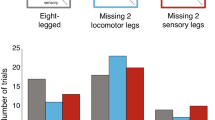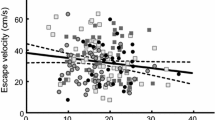Abstract
Fluctuating asymmetry (FA) is often thought to be an indicator of developmental stability—an individual’s ability to resist environmental and genetic stress during development—and thus demonstrates phenotypic quality. Research on the influence of FA on locomotion has often found that high FA in legs and wings impedes locomotor performance. Crickets rely on their six limbs to flee from predators and parasitoids. Hind legs are of particular importance during escape as they contribute to running speed. FA research overwhelmingly focuses on its impact on sexual selection, with little on locomotion and only one study of the impact of FA on invertebrate locomotion. Here, we examined the effect of FA in hind legs on the escape speed of house crickets (Acheta domesticus) and the locomotor costs of hind limb autotomy. Unexpectedly, our findings indicate that FA of hind legs have no influence on the escape speed of either male or female A. domesticus. This is inconsistent with most research conducted on FA and vertebrate locomotion that indicates FA negatively impacts locomotion, but is consistent with the only research examining FA and invertebrate locomotion. Our other findings were more congruent with the literature on other Orthoptera, as body size was found to have an influence on the escape speeds of intact females and those that lost two hind limbs. Whilst our results indicate that FA did not influence locomotion, this may not be the case for other invertebrate taxa where variation in FA may have an important role in natural selection.



Similar content being viewed by others
References
Allen GR (1995) The calling behaviour and spatial distribution of male bushcrickets (Sciarasaga quadrata) and their relationship to parasitism by acoustically orienting tachinid flies. Ecol Entomol 20:303–310
Autrum H et al (2012) Comparative physiology and evolution of vision in invertebrates: a: invertebrate photoreceptors. Springer Science & Business Media
Balmford A, Jones IL, Thomas AL (1993) On avian asymmetry: evidence of natural selection for symmetrical tails and wings in birds. Proc R Soc Lond B Biol Sci 252:245–251
Bateman PW (2001) Changes in phonotactic behavior of a bushcricket with mating history. J Insect Behav 14:333–343
Bateman PW, Fleming PA (2005) Direct and indirect costs of limb autotomy in field crickets, Gryllus bimaculatus. Anim Behav 69:151–159. https://doi.org/10.1016/j.anbehav.2004.04.006
Bateman PW, Fleming PA (2006a) Increased susceptibility to predation for autotomized house crickets (Acheta domestica). Ethology 112:670–677
Bateman PW, Fleming PA (2006b) Sex and the single (−eared) female: leg function, limb autotomy and mating history trade-offs in field crickets (Gryllus bimaculatus). Biol Lett 2:33–35. https://doi.org/10.1098/rsbl.2005.0408
Bateman PW, Fleming PA (2006c) Sex, intimidation and severed limbs: the effect of simulated predator attack and limb autotomy on calling and emergence behaviour in the field cricket Gryllus bimaculatus. Behav Ecol Sociobiol 59:674–681
Bateman P, Fleming P (2009) There will be blood: autohaemorrhage behaviour as part of the defence repertoire of an insect. J Zool 278:342–348
Baxter C (1979) Cricket predation by the northern grasshopper mouse. Behav Neural Biol 27:201–213
Belwood JJ, Morris GK (1987) Bat predation and its influence on calling behavior in neotropical katydids. Science 238:64–67
Braña F, Ji X (2000) Influence of incubation temperature on morphology, locomotor performance, and early growth of hatchling wall lizards (Podarcis muralis). J Exp Zool 286:422–433
Brautiga SE, Persons MH (2003) The effect of limb loss on the courtship and mating behavior of the wolf spider Pardosa milvina (Araneae: Lycosidae). J Insect Behav 16:571–587
Campo J, Davila S, Prieto M, Gil M (2012) Associations among fluctuating asymmetry, tonic immobility duration, and flight distance or ease of capture in chickens. Poult Sci 91:1575–1581
Castillo RC, Núñez-Farfán J (2008) The evolution of sexual size dimorphism: the interplay between natural and sexual selection. J Orthop Res 17:197–200
Clarke GM, Yen JL, McKenzie JA (2000) Wings and bristles: character specificity of the asymmetry phenotype in insecticide-resistant strains of Lucilia cuprina. Proc R Soc Lond B Biol Sci 267:1815–1818
Csada RD, Neudorf DL (1995) Effects of predation risk on mate choice in female Acheta domesticus crickets. Ecol Entomol 20:393–395
Dangles O, Pierre D, Christides J, Casas J (2007) Escape performance decreases during ontogeny in wild crickets. J Exp Biol 210:3165–3170
De Coster G, Van Dongen S, Malaki P, Muchane M, Alcántara-Exposito A, Matheve H, Lens L (2013) Fluctuating asymmetry and environmental stress: understanding the role of trait history. PLoS One 8:e57966
Dongen S (2006) Fluctuating asymmetry and developmental instability in evolutionary biology: past, present and future. J Evol Biol 19:1727–1743
Engqvist L (2005) The mistreatment of covariate interaction terms in linear model analyses of behavioural and evolutionary ecology studies. Anim Behav 70:967–971
Ercit K, Martinez-Novoa A, Gwynne DT (2014) Egg load decreases mobility and increases predation risk in female black-horned tree crickets (Oecanthus nigricornis). PLoS One 9:e110298
Evans MR, Martins TL, Haley M (1994) The asymmetrical cost of tail elongation in red-billed streamertails. Proc R Soc Lond B Biol Sci 256:97–103
Fleming PA, Bateman PW (2007) Just drop it and run: the effect of limb autotomy on running distance and locomotion energetics of field crickets (Gryllus bimaculatus). J Exp Biol 210:1446–1454. https://doi.org/10.1242/jeb.02757
Fleming PA, Muller D, Bateman PW (2007) Leave it all behind: a taxonomic perspective of autotomy in invertebrates. Biol Rev 82:481–510. https://doi.org/10.1111/j.1469-185X.2007.00020.x
Freckleton RP (2002) On the misuse of residuals in ecology: regression of residuals vs. multiple regression. J Anim Ecol 71:542–545
Galeotti P, Vicario V (2005) Fluctuating asymmetry in body traits increases predation risks: tawny owl selection against asymmetric woodmice. Evol Ecol 19:405–418
Guffey C (1999) Costs associated with leg autotomy in the harvestmen Leiobunum nigripes and Leiobunum vittatum (Arachnida: Opiliones). Can J Zool 77:824–830
Gwynne DT (1984) Sexual selection and sexual differences in Mormon crickets (Orthoptera: Tettigoniidae, Anabrus simplex). Evolution 38:1011–1022
Gwynne DT (1993) Food quality controls sexual selection in Mormon crickets by altering male mating investment. Ecology 74:1406–1413
Hedrick AV, Dill LM (1993) Mate choice by female crickets is influenced by predation risk. Anim Behav 46:193–196
Honěk A (1993) Intraspecific variation in body size and fecundity in insects: a general relationship. Oikos 66:483–492
Irschick DJ (2003) Measuring performance in nature: implications for studies of fitness within populations. Integr Comp Biol 43:396–407
Leandro C, Jay-Robert P, Vergnes A (2017) Bias and perspectives in insect conservation: a European scale analysis. Biol Conserv 215:213–224
Lens L, Van Dongen S, Kark S, Matthysen E (2002) Fluctuating asymmetry as an indicator of fitness: can we bridge the gap between studies? Biol Rev 77:27–38
Lessells C, Boag PT (1987) Unrepeatable repeatabilities: a common mistake. Auk 104:116–121
Lewkiewicz DA, Zuk M (2004) Latency to resume calling after disturbance in the field cricket, Teleogryllus oceanicus, corresponds to population-level differences in parasitism risk. Behav Ecol Sociobiol 55:569–573
López P, Martín J (2002) Locomotor capacity and dominance in male lizards Lacerta monticola: a trade-off between survival and reproductive success? Biol J Linn Soc 77:201–209
Manning J, Ockenden L (1994) Fluctuating asymmetry in racehorses. Nature 370:185–186
Martín J, López P (2001) Hindlimb asymmetry reduces escape performance in the lizard Psammodromus algirus. Physiol Biochem Zool 74:619–624
Miura K (2017) Patterns in the autotomized adults of two sympatric, closely related grasshopper species in their natural habitat. Ecol Res 32:379–385
Miura K, Ohsaki N (2015) The cost of autotomy caused by the parasitoid fly Blaesoxipha japonensis (Diptera: Sarcophagidae): an interspecific comparison between two sympatric grasshopper host species. Ecol Res 30:33–39
Møller AP (1997) Developmental stability and fitness: a review. Am Nat 149:916–932
Møller AP, Pomiankowski A (1993) Fluctuating asymmetry and sexual selection. Genetica 89:267–279
Paukner A, Wooddell LJ, Lefevre CE, Lonsdorf E, Lonsdorf E (2017) Do capuchin monkeys (Sapajus apella) prefer symmetrical face shapes? J Comp Psychol 131(73):73–77
Plăiaşu R, Băncilă RI (2018) Fluctuating asymmetry as a bio-marker to account for in conservation and management of cave-dwelling species. J Insect Conserv 22:221–229
Puts DA (2010) Beauty and the beast: mechanisms of sexual selection in humans. Evol Hum Behav 31:157–175
Sakaluk SK, Belwood JJ (1984) Gecko phonotaxis to cricket calling song: a case of satellite predation. Anim Behav 32:659–662
Swaddle JP (1997a) Developmental stability and predation success in an insect predator-prey system. Behav Ecol 8:433–436
Swaddle JP (1997b) Within-individual changes in developmental stability affect flight performance. Behav Ecol 8:601–604
Swaddle JP, Witter MS, Cuthill IC, Budden A, McCowen P (1996) Plumage condition affects flight performance in common starlings: implications for developmental homeostasis, abrasion and moult. J Avian Biol 27:103–111
Tauber E, Camhi J (1995) The wind-evoked escape behavior of the cricket Gryllus bimaculatus: integration of behavioral elements. J Exp Biol 198:1895–1907
Thomas AL (1993) The aerodynamic costs of asymmetry in the wings and tail of birds: asymmetric birds can't fly round tight corners. Proc R Soc Lond B Biol Sci 254:181–189
Valen LV (1962) A study of fluctuating asymmetry. Evolution 16:125–142
Watson PJ, Thornhill R (1994) Fluctuating asymmetry and sexual selection. Trends Ecol Evol 9:21–25
Whitman DW (2008) The significance of body size in the Orthoptera: a review. J Orthop Res 17:117–134
Wilson EO (1987) The little things that run the world (the importance and conservation of invertebrates). Conserv Biol 1:344–346
Zuk M, Kolluru GR (1998) Exploitation of sexual signals by predators and parasitoids. Q Rev Biol 73:415–438
Zuk M, Rotenberry JT, Tinghitella RM (2006) Silent night: adaptive disappearance of a sexual signal in a parasitized population of field crickets. Biol Lett 2:521–524
Acknowledgements
We would like to thank Raoul Bonini for his assistance during the speed trials.
Author information
Authors and Affiliations
Corresponding author
Electronic supplementary material
ESM 1
(DOCX 14 kb)
Rights and permissions
About this article
Cite this article
Pears, J.B., Ferguson, S.M., Boisvert, C.A. et al. Does fluctuating asymmetry of hind legs impose costs on escape speed in house crickets (Acheta domesticus)?. acta ethol 22, 39–45 (2019). https://doi.org/10.1007/s10211-018-0305-8
Received:
Revised:
Accepted:
Published:
Issue Date:
DOI: https://doi.org/10.1007/s10211-018-0305-8




